Australian residential architectural styles
Australian residential architectural styles have evolved significantly over time, from the early days of structures made from relatively cheap and imported corrugated iron (which can still be seen in the roofing of historic homes) to more sophisticated styles borrowed from other countries, such as the Victorian style from the United Kingdom, the Georgian style from North America and Europe and the Californian bungalow from the United States. A common feature of the Australian home is the use of fencing in front gardens, also common in both the UK and the US.

Climate has also influenced housing styles, with balconies and veranda spaces being more prevalent in subtropical Queensland due to the mild, generally warm winters experienced in the state. For many years, Australian homes were built with little understanding of the Australian climate and were widely dependent on European styles that were unsympathetic to Australian landscapes. In recent times, modern Australian residential architecture has reflected the climatic conditions of the country, with adaptations such as double and triple glazing on windows, coordination considerations, use of east and west shade, sufficient insulation, strongly considered to provide comfort to the dweller.
Another aspect of Australian suburbia is that the suburbs tend to have a combination of both upper middle class and middle class housing in the same neighbourhood. In Melbourne, for instance, one early observer noted that "a poor house stands side by side with a good house."[1] This is somewhat less common today, with home renovations, gentrification and the teardown ("knock down, rebuild") method becoming more and more common in affluent suburbs, giving a broader distinction between wealthy and lower class areas. However, the teardown technique has led to home buyers purchasing land or older homes in poorer metropolitan areas and building extravagant homes on the land, which look out of place and excessive, failing to match with the remaining houses in the street.[1]
Variation of styles
Because architectural styles have varied in Australia over the years (from villas to bungalows and brick renders), there is a slight inconsistency in the architectural flow of the suburban streets, with one writer noting that Australian housing styles tend to comingle and coexist awkwardly.[2] This is less common in the United States of America and England, because most of the homes had been long established well into the 19th century and reflect a similar style in both regions. Home planners and architects in Australia have suggested adapting similar styles of new homes with the surrounding established homes to create a sense of uniformity.
"In Australia, the artificial background of life is all highs and lows. A modernistic folly in multi-coloured brickwork may sit next door to a Georgian mansionette on one side and a sensible work of architectural exploration on the other."
Pre-Colonial Period ~40,000 BCE – 1788 CE
.jpg)
Indigenous Australians are traditionally semi-nomadic, rotating between different areas in conjunction with the seasons in order to harvest and maintain crops. They managed the land through controlled burning practices involving a biennial burning-off which stunted forest growth and encouraged crop germination.[3]
The housing of the Eora people first encountered by Europeans in the Sydney region were shelters constructed of a semicircle of stick, covered with large sheets of bark which could be conveniently stripped off Melaleuca trees which grew profusely along waterways. Other types of simple structures were seen including lean-tos and in tropical regions raised sleeping platforms. Grass, leaves and reeds were used as a thatch where suitable bark was not available.[4]
There are instances of Indigenous peoples constructing partially using dry-stone wall techniques in Western Australia.[5] The Aboriginal people also built dry-stone Fish Traps, of which the most extensive, ranging over 500 metres, is on the Barwon River at Brewarrina. Its age is unknown. It has been maintained and rebuilt after floods many times and is said traditionally to have been given to the local clans by the Creator Spirit.
It appears that in conjunction with such catchment schemes, there may have also been nearby sedentary settlements of people who maintained them.[6] There is evidence at Lake Condah in Victoria of houses in conjunction with eel traps dating back about 8,000 years. [7]
In January 2006, bushfires uncovered another nearby site of a village of stone houses that are large enough to have provided sleeping space for several families.[8]
Old Colonial Period 1788 – c. 1840
Colonial Architecture is the term used for the buildings constructed in Australia between European settlement in January 1788 and about 1840.
The first buildings of the British penal settlement in Sydney were a prefabricated house for the Governor and a similarly prefabricated Government Store to house the colony's supplies. Sydney was a tent settlement. Building anything more substantial was made unnecessarily difficult by the poor quality of spades and axes that had been provided and the shortage of nails.
The convicts adapted simple country techniques commonly used for animal shelters and the locally available materials to create huts with wattle-and-daub walls. So useful were the local acacia trees for weaving shelters that they were given the name Wattle. Some pipe clay was obtained from the coves around Port Jackson. Bricks were fired in wood fires and were therefore soft. Lime for cement was obtained by burning oyster shells.
The first imported roofing material was corrugated iron sheeting. Roofs of this type were to become part of the Australian vernacular. For many years imported roofing was in very short supply. Two local roofing materials were available- there were extensive reed beds near the Cook's river for thatching. There was also bark which could be peeled off a number of the indigenous trees in large sheets. Methods of heating and flattening the bark were used by the Aboriginal people and these were quickly assimilated by the convict builders.
The two most significant trees, both of which grew in the Sydney area, were the Melaleuca and the Iron Bark. The Melaleuca bark, having the texture of paper, could be peeled off the tree in layers up to 2 centimetres (0.79 in) thick, a metre long and perhaps half a metre wide without serious damage to the tree. Although not particularly durable as exterior roofing, the material provided excellent insulation and was used for ceilings and lining the walls.
The resilient bark from the Iron-bark tree was adapted as a major building material everywhere that such trees grew. It was widely used as a roofing material, was weatherproof, insulating and could last for thirty years. Houses of axe-hewn slabs with Iron-bark roofs continued to be built in rural Australia until WWII.
As better tools became available the Colonial builders became adept at working the extremely hard and durable timber of the native hardwood forests. The majority of houses were built of split logs rather than sawn timber. The technique employed for the construction of a wall was to chisel out a deep groove in a straight log, preferably of the local termite-resistant Cyprus pine which became the foundation. Split logs that had been adzed flat at the ends were then stood in the groove and another groove log was placed on top and slotted into place in a circular corner post. The gaps between the split logs were either packed with clay and animal hair or had narrow strips of metal cut from kerosene tins tacked over them. The interior could be plastered with clay, lined with paperbark or papered with newspaper, wrapping paper or calico. Cards, photographs, news clippings and commemorative items were often stuck directly onto the walls.
The technique of making durable hardwood roofing shingles was also developed. Where these shingles have been applied to brick houses, they have sometimes survived to the 21st century, covered by subsequent corrugated iron roofs.
In the earliest houses windows were usually small, and multi-paned with cylinder glass. When the cost of glass put it beyond reach of the home-owner, blinds of oiled calico were tacked across window openings in the winter months.
Types of buildings
The simplest houses were of a single room, which, if the bread-winner prospered, became the kitchen to a more substantial residence, or conversely, became the living room with a lean-to kitchen added. Houses that grew piecemeal were generally asymmetrical, with the door leading into the original room.
Houses that were planned were generally symmetrical, and very simple, usually containing 2 to 4 rooms around a central hallway. The kitchen was frequently detached and entered from a rear verandah or covered breezeway where pantry or scullery might also be located. Fireplaces projected outwards from the walls of the house. Except in the case of some small inner-city Georgian row houses built of brick, houses generally had a verandah added to them, often on three sides.
One class of people who maintained the tradition of wattle and daub, with a bark roof was the squatters who did not have title to their land, and potentially had to move on every two years.
Very few 19th-century houses of wattle and daub or split timber have survived. A small number of split-timber cottages which later became kitchens may be seen adjacent to more substantial homes, generally painted to match the house and barely recognizable.
Most buildings erected in the first 50 years of Australian settlement were simple and plain. Convict huts, marine barracks, government stores and houses for officials were simple rectangular prisms covered with hipped or gabled roofs often with verandahs supported on wooden columns in the Classical manner. They were influenced in particular by the regulation British military buildings in India and other tropical locations.
At the time of the first settlement, Georgian architecture was the architectural vernacular in Britain. Craftsmen, including carpenters and plasterers were trained in the classic proportions associated with the Palladian style fashionable across Europe. Palladian ideals reveal themselves in some of the few larger homes of the Regency period such as “Elizabeth Bay House”. Neoclassism incorporating not only Greek but also sometimes Ancient Egyptian motifs, beginning in Europe about 1760, also influenced Australian architectural style. “Fernhill” at Mulgoa with its wide colonnaded verandah shows the influence of Neoclassicism. As the Australian economy developed and settlements became more established, more sophisticated buildings emerged.
Old Colonial Georgian Style
 Elizabeth Farm cottage, Parramatta, New South Wales; completed in 1793; one of the oldest surviving residences in Australia
Elizabeth Farm cottage, Parramatta, New South Wales; completed in 1793; one of the oldest surviving residences in AustraliaExperiment_Farm_Cottage_119.jpg) Experiment Farm Cottage, Harris Park, New South Wales; completed 1795
Experiment Farm Cottage, Harris Park, New South Wales; completed 1795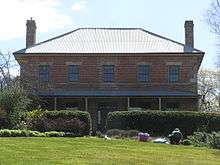 Harper's Hill, Berrima, New South Wales
Harper's Hill, Berrima, New South Wales Harrisford House, Parramatta, New South Wales; completed 1820s
Harrisford House, Parramatta, New South Wales; completed 1820s Brislington, Parramatta; completed 1821
Brislington, Parramatta; completed 1821.jpg) Oatlands Coach House, Oatlands, Tasmania
Oatlands Coach House, Oatlands, Tasmania.jpg) Houisons House, Parramatta, New South Wales
Houisons House, Parramatta, New South Wales Eschol Park House; New South Wales
Eschol Park House; New South Wales Bowmans Cottage, Richmond, New South Wales; completed 1815
Bowmans Cottage, Richmond, New South Wales; completed 1815.jpg) Terraces, Millers Point, New South Wales
Terraces, Millers Point, New South Wales Linden House, Parramatta, New South Wales
Linden House, Parramatta, New South Wales.jpg) Old Government House, Parramatta, New South Wales; completed between 1799 and 1820
Old Government House, Parramatta, New South Wales; completed between 1799 and 1820
Old Colonial Regency Style
 Horbury Terrace, Sydney. Completed 1842
Horbury Terrace, Sydney. Completed 1842Tusculum_Potts_Point.jpg) Tusculum, Potts Point, New South Wales. Completed 1837
Tusculum, Potts Point, New South Wales. Completed 1837Rockwall_in_Potts_Point.jpg) Rockwall House, designed by John Verge, in Potts Point, New South Wales
Rockwall House, designed by John Verge, in Potts Point, New South Wales- Elizabeth Bay House, Elizabeth Bay, New South Wales, also designed by John Verge
- Clarendon House, Evandale, Tasmania; completed in 1838[9]
 Panshanger, near Longford, Tasmania
Panshanger, near Longford, Tasmania.jpg) Toxana, Richmond, New South Wales. 1842
Toxana, Richmond, New South Wales. 1842
Old Colonial Grecian Style
Old Colonial Gothic Picturesque
- Conservatorium of Music, Sydney, designed by Francis Greenway
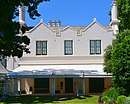 Lindesay, Darling Point, New South Wales
Lindesay, Darling Point, New South Wales
Victorian Period c. 1840 – c. 1890
- Gothic Revival
1840–1880
During the Victorian era, the British Empire, including Australia, was yet heavily Anglican, and thus subject to the influence of the Oxford and Cambridge Movements, which favored the use of Gothic Revival architecture. Thus, while a local magnate may have built his home in a classical style, he would potentially fund a church in the Gothic style. Thus, during the 19th century, when Australia was expanding rapidly, two forms of architecture were very evident: Gothic and the Classical styles. Originally Gothic was for God, and the Classical for the man. Later a new "self-made" Australian began to emerge, unhindered by a classical British education dictating classical gentlemanly interests. This "new" self-made man (like his contemporaries in Britain) would often choose Gothic as the design for his home.
The great cathedrals of the Middle Ages during the Gothic period of ecclesiastical architecture formed the inspiration for this particular architectural style; not only in residential buildings, but in many commercial structures, churches and cathedrals built during this time. St. Paul's and St. Patrick's Cathedrals in Melbourne are excellent examples of the Gothic Revival period, often referred to as Victorian Gothic. Characteristics were: steeply pitched roofs often made of slate, narrow doors and windows resolving in a Gothic pointed arch at their height (known as lancet windows), diamond pane glazing to windows imitating a stained glass affect, and intricate parapets, often of a religious nature, with a cross. In non-terrace houses, the drawing room was often pulled forward, adding a bay window to the front of the dwelling.

The Victorian style in Australia can be divided into 3 periods: Early, Mid and Late. The period in its entirety stretches from 1837 to 1901 and was named after the then Queen, Queen Victoria. Early styles featured symmetrical layouts and façades, a centrally located front door and a hipped roof of corrugated iron, leading to a veranda on the façade. During the 1850s cast-iron lacework came to Australia, where it made its way on to Mid and Late Victorian Homes with much the same floor plan as the Colonial Style, a central hallway with a standard 4 rooms. Weatherboards were often used, although larger homes used red brick and blue stone. In the Mid Victorian Style, decoration began to gain popularity. The bullnosed veranda roof was introduced, sidelights were added either side of the front door, and terraced houses were springing up everywhere, containing parapets and detailed dividing walls between the property boundaries. Late Victorian Style homes had perhaps the most decorative features in all of the known architectural styles to date, which is often referred to as Boom Style. Towards the end of the Victorian era, timber fretwork was being used more and more, which led into the Edwardian/Federation Styles.
Queenslander style
The Queenslander style house is characterized by an all timber painted exterior, a timber stud frame, and a floor raised on piles for air flow in hot climate. They have wide verandahs (often the length of the house and enclosed by shutters, and roofs are gabled and corrugated iron. The street facing view is often symmetrical. The NSW Queenslander is often smaller than the original classic Queenslander and is less decorative probably due to limited supply of delicate timber detail and trades-people to build them. It is sometimes combined with the Ranch style house.
From the 1840s, a specific style of building emerged in Queensland. The Queenslander style of houses are identifiable by large verandahs and large double doors which open onto these verandahs, stilts rising the house above ground level (particularly in older houses), metal roofs typically of corrugated design and the houses are always constructed of mostly wood.
- Federation-style Queenslander
- Inter-war Queenslander
 Victorian era Queenslander
Victorian era Queenslander A typical 'Queenslander' style house in Brisbane
A typical 'Queenslander' style house in Brisbane.jpg) An old Queenslander in Kilcoy
An old Queenslander in Kilcoy
- Early, Mid and Late Victorian
1845–1900 The styles during this period were: Georgian, Regency, Egyptian, Academic Classical, Free Classical, Filligree, Mannerist, Second Empire, Italianate, Romanesque, Academic Gothic, Free Gothic, Tudor, Rustic Gothic and Carpenter Gothic. Of these fifteen styles, the following seven were normally used for residential architecture:
Georgian Revival
A typical Victorian Georgian house of the 19th century was simple, elegant and formal in style. The style is sometimes called Georgian Revival to avoid confusion with Old Colonial Georgian architecture.
 Juniper Hall, Oxford Street, Paddington, New South Wales; built 1824-25[10]
Juniper Hall, Oxford Street, Paddington, New South Wales; built 1824-25[10] Woodlands, Killara, New South Wales. Completed 1884
Woodlands, Killara, New South Wales. Completed 1884 Durham Hall, Albion Street, Surry Hills, New South Wales
Durham Hall, Albion Street, Surry Hills, New South WalesVictoria_Street_house.jpg) House in Potts Point, New South Wales, with typical Victorian Georgian features
House in Potts Point, New South Wales, with typical Victorian Georgian features Argyle Place terraces, Millers Point, Sydney[11]
Argyle Place terraces, Millers Point, Sydney[11]- Cleveland House, Surry Hills, New South Wales, possibly designed by Francis Greenway
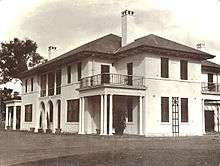
Regency
The Regency style was a refinement of Georgian, with elaborations like a portico with columns at the front of the house.
Merrivale.jpg) Merrivale, Pymble, New South Wales
Merrivale, Pymble, New South WalesJenner_House_Potts_Point-2.jpg) Jenner House, Potts Point, New South Wales
Jenner House, Potts Point, New South Wales%2C_Millers_Point.jpg) Terraces in Millers Point, Sydney
Terraces in Millers Point, Sydney Royal Terrace, Carlton, Victoria
Royal Terrace, Carlton, Victoria Cyprus Terrace, East Melbourne, Victoria
Cyprus Terrace, East Melbourne, Victoria_Admiralty_House2.jpg) Admiralty House, Kirribilli, New South Wales
Admiralty House, Kirribilli, New South Wales Ayers House, North Terrace, Adelaide, South Australia
Ayers House, North Terrace, Adelaide, South Australia
Filigree
As housing developed in Australia, verandas became important as a way of shading the house. From the mid-19th century in particular, as people became more affluent, they built more elaborate homes, and one of the favoured elaborations was the filigree, or screen, of cast iron or wrought iron. This developed to the point where it has become one of the major features of Australian architecture. Many homes with this feature are also considered Italianate architecture, the filigree element being the wrought iron balcony.
 Holcombe Terrace. One of Australia's best examples of the residential filigree style executed in polychrome brick. Carlton, Victoria
Holcombe Terrace. One of Australia's best examples of the residential filigree style executed in polychrome brick. Carlton, Victoria- Terraced houses in the Sydney suburb of Glebe, with wrought iron balconies
 Filigree architecture in Queenscliff, Victoria
Filigree architecture in Queenscliff, Victoria
Italianate
The Italianate style developed as a result of French painters who idealised the Italian landscape and turned it into their version of Arcadia. Their influence was long-lasting and eventually led to the Italianate architectural style of the 19th century. The style featured asymmetry and, usually, a tower of varying size. In Australia, the addition of the verandah, sometimes arcaded but later in Filigree (wrought iron), gave a regional flavour to the style.
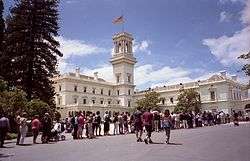 Government House, Melbourne, Victoria; completed in 1876
Government House, Melbourne, Victoria; completed in 1876 Eynesbury House, Kingswood, South Australia; completed in 1881[13]
Eynesbury House, Kingswood, South Australia; completed in 1881[13]- Kenilworth, Annandale, New South Wales
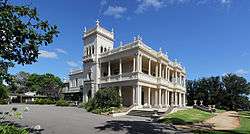 Kamesburgh, North Road, Brighton, Victoria
Kamesburgh, North Road, Brighton, VictoriaItalianate_home_Lang_Rd.jpg) Walshome, Centennial Park, New South Wales
Walshome, Centennial Park, New South Wales- Shruba Hall, Croydon, New South Wales
 Roslyn, Coogee, New South Wales
Roslyn, Coogee, New South WalesItalianate_home_Dutruc_Street_Randwick-1.jpg) Earlswood, Randwick, New South Wales
Earlswood, Randwick, New South Wales Bishopscourt, East Melbourne, Victoria; completed in 1853
Bishopscourt, East Melbourne, Victoria; completed in 1853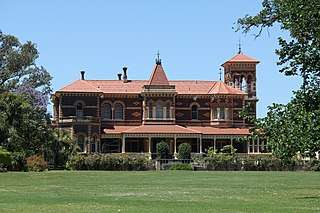 Rippon Lea, Elsternwick, Victoria
Rippon Lea, Elsternwick, Victoria
 Epworth, Richmond, Victoria
Epworth, Richmond, Victoria Myrnong Hall, Acland Street, St Kilda, Victoria
Myrnong Hall, Acland Street, St Kilda, Victoria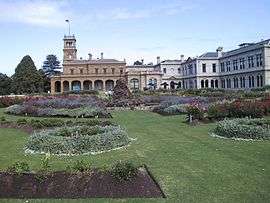 Werribee Park, Werribee, Victoria; completed in 1877[14]
Werribee Park, Werribee, Victoria; completed in 1877[14]
Free Gothic
The Gothic style gained favour from the early days of Queen Victoria's reign. Free Gothic became a popular choice for architects and their clients because it was not concerned with historical correctness and therefore gave them greater freedom in their designs. The style was much in vogue for religious buildings but was sometimes used in residential architecture as well.
Gladswood_House-A.jpg) Gladswood House, Double Bay, New South Wales. Completed 1860s
Gladswood House, Double Bay, New South Wales. Completed 1860s The Abbey, Annandale, New South Wales.[15]
The Abbey, Annandale, New South Wales.[15]- Cloncorrick, Darling Point, New South Wales
.jpg) Tulloona, Goonellabah, New South Wales. Completed 1896
Tulloona, Goonellabah, New South Wales. Completed 1896
Tudor
The Tudor style grew out of a nostalgia for older English concepts, particularly focused on the days of Queen Elizabeth I and Henry VIII. Its role in Australia began when the English architect Edward Blore designed Government House in Sydney in 1834. The style spread all over Australia and also influenced later styles like Federation Queen Anne and Inter-War Old English.
Swifts.jpg) Swifts, Darling Point, New South Wales. Designed in 1882, this house later became the official residence of the Catholic Archbishop of Sydney.
Swifts, Darling Point, New South Wales. Designed in 1882, this house later became the official residence of the Catholic Archbishop of Sydney.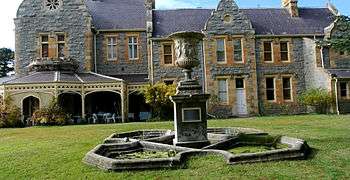 Abercrombie House, Bathurst, New South Wales. Completed 1878
Abercrombie House, Bathurst, New South Wales. Completed 1878 Carthona, Darling Point, New South Wales
Carthona, Darling Point, New South Wales
Rustic Gothic
The Rustic Gothic style developed out of a "cult of the picturesque" which largely focused on rural images and especially the picturesque "rustic house", which became known as the cottage orne. In Australia, this style had a great appeal to British settlers who still carried with them a hankering for things English.
 13 & 15 James Street, Richmond, Victoria. Completed 1857.
13 & 15 James Street, Richmond, Victoria. Completed 1857.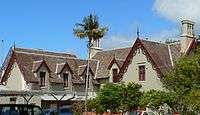 Glenfern, East St Kilda. Completed 1857.
Glenfern, East St Kilda. Completed 1857. 157 Hotham Street, East Melbourne, Victoria. Completed 1861.
157 Hotham Street, East Melbourne, Victoria. Completed 1861.- Rectory of St Mark's Church, Darling Point, New South Wales. Designed by Edmund Blacket.
- Semi-detached houses in Sydney
_Callooa(1).jpg) Callooa, Darling Point, New South Wales
Callooa, Darling Point, New South Wales
Classical

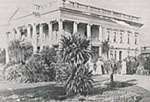 Earlsbrae Hall, Essendon, Victoria
Earlsbrae Hall, Essendon, Victoria Valentine's Mansion, Malvern, Victoria
Valentine's Mansion, Malvern, Victoria Biltmore apartments, Albert Park, Victoria
Biltmore apartments, Albert Park, Victoria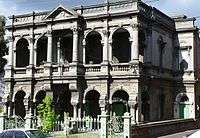 Lalor House, Richmond, Victoria
Lalor House, Richmond, Victoria Drummond Terrace, Carlton, Victoria
Drummond Terrace, Carlton, Victoria- Corana and Hygeia Terraces, Randwick, New South Wales
- Curzon Hall, Marsfield, New South Wales
 IIfracombe and Clovelly Terraces, Randwick, New South Wales
IIfracombe and Clovelly Terraces, Randwick, New South Wales Terraces in Potts Point, New South Wales
Terraces in Potts Point, New South Wales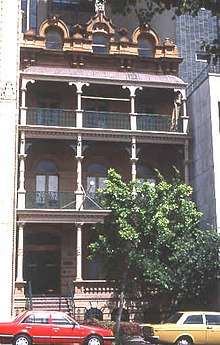 "History House" terrace, Macquarie Street, Sydney
"History House" terrace, Macquarie Street, Sydney
Second Empire
Second Empire was preferred for grander mansions. For the rich, particularly in the wealthier parts of the larger metropolitan areas, the style evoked images of French aristocracy. Although rare, examples can be found in the bigger cities. Distinctive features include towers, quoining, mansard and slate roofs, square domes dormer windows, iron cresting and rich classical details. In the Australian setting, domestic interpretations of the style often combined filigree elements such as cast iron verandahs.
 Labassa, Manor Grove, Caulfield North, Victoria
Labassa, Manor Grove, Caulfield North, Victoria Marion Terrace, Burnett Street, St Kilda, Victoria
Marion Terrace, Burnett Street, St Kilda, Victoria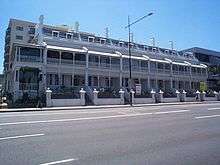 Cook's Terrace, Coronation Drive, Brisbane
Cook's Terrace, Coronation Drive, Brisbane Goodrest, Cnr Leopold and Toorak Roads, South Yarra, Victoria
Goodrest, Cnr Leopold and Toorak Roads, South Yarra, Victoria Stonington, Glenferrie Road, Malvern, Victoria
Stonington, Glenferrie Road, Malvern, Victoria- House, Pasley Street, South Yarra, Victoria
 Seaside apartments, Queenscliff, Victoria
Seaside apartments, Queenscliff, Victoria
Federation period c. 1890 – c. 1915
The Edwardian style was named after King Edward (1901–1910) at the time, and was the predominant style in the United Kingdom and its colonies. The style draws on elements of the Victorian era and the earlier Queen Anne style of the early 18th century. The Edwardian style coincided with the Federation of Australia. Thus, the Federation style was, broadly speaking, the Australian version of the Edwardian, but differed from the Edwardian in the use of Australian motifs, like kangaroos, the rising sun (of Federation), and emus, Australian flora and geometric designs. Some of the most recognisable Federation/Edwardian features include red brick exteriors with embellished wood detail known as fretwork. Cream painted decorative timber features, tall chimneys were all common. Stained glass windows towards the front of the home became increasingly popular during this period. Internally, Victorian-era features were still evident, including plaster ceiling roses and cornices and timber skirting and architraves. Federation style depicted a Tudor type look, especially on gables, and Edwardian gave a simpler cottage look. Terracotta tiles or galvanised iron are generally used for roofing, which is designed with a steep pitch. The gable ends and roof eaves often feature ornate timber brackets, and timber detailing and fretwork are a common inclusion on verandahs.[16]
Some consider that this style was the Federation version of the Queen Anne style. Other styles during this period were Federation Academic Classical, Federation Free Classical, Federation Filligree, Federation Anglo-Dutch, Federation Romanesque, Federation Gothic, Federation Carpenter Gothic, Federation Warehouse, Federation Free Style, Federation Arts and Crafts and Federation Bungalow. The names all indicated very similar styles with features so minute separating them. Out of the twelve Federation styles, however, only the following four were normally used in residential architecture:
Federation Queen Anne
 Edwardian home in Albert Park, Victoria
Edwardian home in Albert Park, VictoriaCaerleon.jpg) Caerleon, Bellevue Hill, New South Wales, the first Queen Anne home in Australia
Caerleon, Bellevue Hill, New South Wales, the first Queen Anne home in Australia- House in Appian Way, Burwood, New South Wales
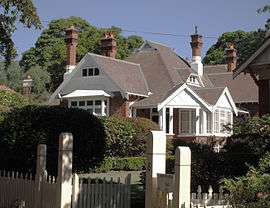 Olevanus in Burwood, New South Wales
Olevanus in Burwood, New South Wales Residence in Coogee, New South Wales
Residence in Coogee, New South Wales_The_Annery1.jpg) The Annery, Darling Point, New South Wales
The Annery, Darling Point, New South Wales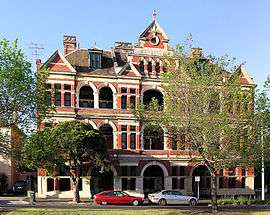 Queen Bess Row in East Melbourne, the largest Queen Anne-styled terrace in Melbourne
Queen Bess Row in East Melbourne, the largest Queen Anne-styled terrace in Melbourne Edwardian house, Heidelberg, Victoria
Edwardian house, Heidelberg, Victoria A Queen Anne residence in Ivanhoe, Victoria
A Queen Anne residence in Ivanhoe, Victoria- West Maling, Penshurst, New South Wales
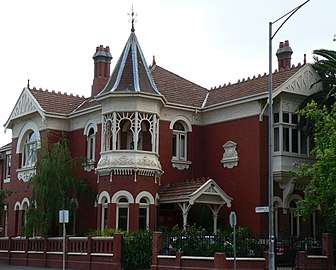 Federation mansion in South Yarra, Victoria
Federation mansion in South Yarra, Victoria Federation terraces in Park Street, South Yarra, Victoria
Federation terraces in Park Street, South Yarra, Victoria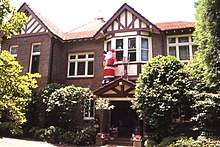 Ingleholme, Turramurra, Sydney
Ingleholme, Turramurra, SydneyStrathmore_Wentworth_Falls.jpg) Strathmore, Wentworth Falls, New South Wales
Strathmore, Wentworth Falls, New South Wales
Federation Arts and Crafts
The Arts and Crafts style came out of a movement to get away from mass-production and rediscover the human touch and the hand-made. The architectural style was characterised by rough-cast walls, shingles, faceted bay windows, stone bases, tall chimneys, high-pitched roofs and overhanging eaves. It was widely used in Australia during the Federation period.
.jpg) Home, Arnold Street, Killara
Home, Arnold Street, Killara.jpg) Waimea Road, Lindfield
Waimea Road, Lindfield Home, Burwood Road, Burwood
Home, Burwood Road, Burwood St Ellero, Appian Way, Burwood
St Ellero, Appian Way, Burwood Erica, Appian Way, Burwood
Erica, Appian Way, Burwood Devon, Martin Road, Centennial Park
Devon, Martin Road, Centennial Park_Hastings1.jpg)
Federation Bungalow
The bungalow style was usually a single-storey house with a prominent veranda, especially with the roof covering the veranda. It is seen as a transition phase between the Federation period and the California bungalow.
 Casa Tasso, Appian Way, Burwood, New South Wales
Casa Tasso, Appian Way, Burwood, New South Wales Ostia, Appian Way, Burwood, New South Wales
Ostia, Appian Way, Burwood, New South Wales Home, Appian Way, Burwood, New South Wales
Home, Appian Way, Burwood, New South Wales Home, Appian Way, Burwood, New South Wales
Home, Appian Way, Burwood, New South Wales- Bungalow, Shaftsbury Road, Burwood, New South Wales
 Arundel, Harrow Road, Bexley, New South Wales
Arundel, Harrow Road, Bexley, New South Wales- Ranger's cottage, Centennial Park, New South Wales, designed by government architect Walter Liberty Vernon
Federation Filigree
The filigree style was characterised by the creation of a screen as a prominent style at the front of the house. In the Victorian period, the screen was made of wrought iron, but in the Federation period it was made of wooden fretwork, which could be quite elaborate. It was widely used in Queensland as a way of providing shade and circulation of air for a home.
 Home, Rockhampton, Queensland
Home, Rockhampton, Queensland Building, Rockhampton, Queensland
Building, Rockhampton, Queensland Home, Rockhampton, Queensland
Home, Rockhampton, Queensland
 Timber fretwork terraces. Madden Street, Albert Park, Victoria
Timber fretwork terraces. Madden Street, Albert Park, Victoria
Inter-War Period c. 1915 – c. 1940
Styles which existed during the 1915-40 period include Edwardian, Georgian Revival, Academic Classical, Free Classical, Bungalow, Mediterranean, Spanish Mission, Art-Deco, Skyscraper Gothic, Romanesque, Gothic and Old English.
Californian Bungalow
1915–1940 This style can almost instantly be recognised by the columns holding up a front veranda area. The name is almost self-explanatory: bungalow, a rugged type of home. This led to the belief that picket fences looked appropriate at the front fence, although originally they were not used. Darker colours were originally used but, as the years went by, new brighter paint served as a welcoming change to open up the spaces and brighten up the homes. Stone, brick and timber, earthy materials were used. A gable roof faced either the front or side always.
 Californian Bungalow, Preston, Victoria
Californian Bungalow, Preston, Victoria Belmont Flats. Alma Road, St Kilda, Victoria; completed 1923. Rare example of the bungalow style applied to an apartment building
Belmont Flats. Alma Road, St Kilda, Victoria; completed 1923. Rare example of the bungalow style applied to an apartment buildingCalifornia_Bungalow_Kensington-1.jpg) Home in Kensington, New South Wales, without the characteristic squat columns
Home in Kensington, New South Wales, without the characteristic squat columnsCalifornia_Bungalow_Sydney-2.jpg) Home in Kensington, New South Wales
Home in Kensington, New South Wales Home in Glandore, South Australia
Home in Glandore, South Australia Bungalow with the characteristic verandah in Pennington, South Australia
Bungalow with the characteristic verandah in Pennington, South Australia
Ashgrovian
1930 onwards
Originally specific to Queensland, the [Ashgrovian style developed from the hipped bungalow style and was characterised by a frontage with a grand gable roof, often surrounded by secondary smaller gables behind, the smaller gables usually sheltering verandahs and sleep-outs. A staircase almost always dominated the front yard leading to the verandah.
Spanish Mission
1925–1939
Distinctly recognised by twisted pylons to a porch area covering the front door, usually windows grouped in threes to the side of the front door area on simpler homes. The style was influenced by the American Spanish inhabitant influenced American Architectural styles. Walls were brick in accordance with council regulations at the time, with white or cream yellowish cream stucco finish and Spanish terra cotta tiles.
 Spanish Mission home in Heidelberg, Victoria
Spanish Mission home in Heidelberg, Victoria Belvedere Flats, The Esplanade, St Kilda, Victoria; completed in 1929.
Belvedere Flats, The Esplanade, St Kilda, Victoria; completed in 1929. Home, Bellevue Hill, New South Wales
Home, Bellevue Hill, New South Wales Marne Court, Marne Street, South Yarra, Victoria
Marne Court, Marne Street, South Yarra, Victoria Santiago, Kingsford, New South Wales
Santiago, Kingsford, New South Wales Apartment complex, Alexandra Parade, South Yarra, Victoria
Apartment complex, Alexandra Parade, South Yarra, Victoria- Las Palmas, St Kilda, Victoria
 Bourne Place, Remodelled Terraces, Windsor, Victoria
Bourne Place, Remodelled Terraces, Windsor, Victoria
Old English
1915–1940 The Old English style involved a certain nostalgia for English ways, and tended to draw on Tudor and such-like English styles harking back vaguely to the days of Henry VIII. It had a certain appeal for what was a predominantly Anglo-Saxon population at the time.
 Home, Bexley Road, Bexley, New South Wales
Home, Bexley Road, Bexley, New South Wales- Home, Robertson Road, Centennial Park, New South Wales
 Deanbury, Billyard Avenue, Wahroonga, New South Wales
Deanbury, Billyard Avenue, Wahroonga, New South Wales- Bonnington, Victoria Road, Bellevue Hill, New South Wales
.jpg) Unley Park, South Australia
Unley Park, South Australia
Early Moderne
1930–1940 A very modern looking style at the time, inspired by a German movement known as Bauhaus, representing functional and clinical architecture. Red or cream brick walls and concrete was also first seen. Steel-framed casement sashes, with larger panes of glass and terra cotta tiled roofs with a moderate pitch. The only featured part of the house included matching decorative front fences, and a featured roof affect.
The Streamline Moderne style was a late branch of the Art Deco style. The style emphasized curving forms, long horizontal lines, and sometimes nautical elements, such as railings and porthole windows. This style was adopted into suburban architecture, most notably in the Waterfall style.
 Burnham Beeches mansion in the Dandenong Ranges outside Melbourne;, completed 1933 in the Streamline Moderne style; designed by Harry Norris
Burnham Beeches mansion in the Dandenong Ranges outside Melbourne;, completed 1933 in the Streamline Moderne style; designed by Harry Norris
Post-War Period c. 1940 – 1960
Austere
The Austere style reflected the lack of availability of building materials and labour in the years following World War II.
Waterfall (Art Deco) 1940 – 1950
Fashionable modern houses of the thirties in the Streamline Moderne style were sometimes described as being like ocean liners, with walls, windows and balconies all sweeping around corners. By the 1940s these details were entrenched into suburban designs. The 'Waterfall' or 'Waterfall Front' style came to be known as such from the use of descending curves in chimneys, fence pillars and other vertical elements. Robin Boyd, the Australian architect and writer, noted that three was 'the key to decorative smartness'; three steps usually being used for the waterfall effect and featured parallel lines were often in threes.
Defining features of houses from this period are curved corner windows, including Venetian blinds, some rare examples of which are curved. With a slightly steeper pitched roof than the Early Modern Style, this style was generally of brick veneer cream brick but also could have dark brown glazed feature brickwork incorporated into the external walls, and under windowsills. Chimneys were either stepped or plain, and together with the round windows perhaps gave meaning to the "Waterfall" name.
Ecclesiastical, International, Melbourne Regional, Brisbane Regional and American Colonial were also styles which existed in the period 1940–1960.
_style_house_in_Eaglemont%2C_Victoria.jpg) The Waterfall style and Art Deco combined, Heidelberg, Victoria
The Waterfall style and Art Deco combined, Heidelberg, Victoria House in Red Hill, Australian Capital Territory, designed by Robin Boyd. Typical of the post-war Melbourne regional style: long unbroken roof line, wide eaves, extensive windows.
House in Red Hill, Australian Capital Territory, designed by Robin Boyd. Typical of the post-war Melbourne regional style: long unbroken roof line, wide eaves, extensive windows.
International style
The Rose Seidler House built by Harry Seidler for his parents between 1948 and 1950 in Sydney incorporated Modernist features of open planning, a minimal colour scheme, and labour saving devices that were new to Australia at the time. The house won the Sir John Sulman Medal in 1951 and is today preserved as a museum as a very influential house.[17]
After the second World War, architects in Australia were influenced by the development of the International style of architecture. Some regional variations developed. In Melbourne, Robin Boyd and Roy Grounds articulated a Melbourne interpretation of the modern style. Boyd's book Victorian Modern (1947) traced the history of architecture in the state of Victoria and described a style of architecture that he hoped would be a response to local surroundings as well as the popular international style. In particular he nominated the work of Roy Grounds and in some outer suburban bush houses of the 1930s as being the early stages of such a style. Grounds and Boyd later worked in partnership.
The houses were typically narrow, linear, and single storey with a low pitched gable roof. They had exposed rafters and wide eaves. Walls were generally bagged or painted brick and windows were large areas of glass with regularly spaced timber mullions.[18]
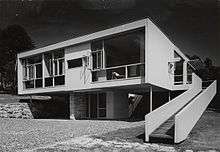 Rose Seidler House in the northern Sydney suburb of Wahroonga, New South Wales
Rose Seidler House in the northern Sydney suburb of Wahroonga, New South Wales
L-Shape 1945 – 1955
This style represented a change in the overall floor plan, the plan resembling a large "L" Shape. Usually with gabled ends to the L, with terra cotta tiles still being used, as concrete tiles didn't appear until the late 1960s. Timber or steel framed windows were used, and front-facing fences resembled the house, much the same as had been seen since the Early Modern Period.
Dutch Colonial
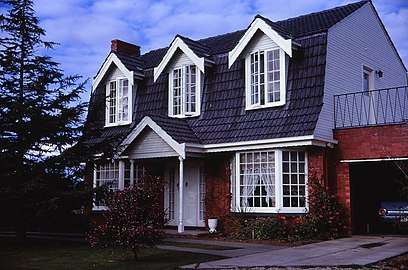 Dutch Colonial home in Adelaide (1950s)
Dutch Colonial home in Adelaide (1950s) Dutch Colonial house in Mitcham, South Australia
Dutch Colonial house in Mitcham, South Australia
Timber and fibro fisherman's cottage
The original fisherman's cottage was built in many coastal towns between the 1930s and 1950s. It was originally a simple timber framed structure of one or two rooms and a verandah which was clad with asbestos sheeting. The floors were generally raised on piles. The verandah sometimes had handsome wooden balustrade that was sometimes enclosed to make an additional room or sleep-out. Timber detail around windows and gables were often painted- cheery red being one of the most popular traditional colours.
The original cottages, being relatively cheap to purchase, are now popular for renovation. Construction is easy and owner-building is common. The older buildings require insulation in the ceiling and walls. Timber and fiber cement sheeting now replaces the original asbestos and often the interior is completed gutted to create a modern open plan style of living. Timber strap-work can be used and windows frames painted for effect.
 Renovated fisherman's cottage
Renovated fisherman's cottage
Triple front (cream brick) 1950 – 1960s
Distinctly recognisable by their front-facing walls have 3 and sometimes even 4 front-facing walls. This led to the front entrance sometimes brought round to the side within one of the alcoves created by the multiple fronts. Roofs were medium pitched and hipped with concrete tiles being used towards the end of the style in the late 60s. Front fences had a castellated top and feature piers raised above the top of the rest of the brick fence. Decorative iron was used very minimally, in gates to driveways, and balustrades to entrances.
_style_house_in_Heidelberg%2C_Victoria.jpg) Triple Front (With 4 Fronts), Heidelberg, Victoria.
Triple Front (With 4 Fronts), Heidelberg, Victoria.
Late twentieth century 1960 – 2000
Styles of the late 20th century have largely been derived from the current world architectural trends, or have been imitative of previous Australian styles. These styles include Stripped Classical, Ecclesiastical, International, Organic, Sydney Regional, Perth Regional, Adelaide Regional, Tropical, Brutalist, Structural, Late Modern, Post Modern, Australian Nostalgic and Immigrants' Nostalgic. In the 1980s and 1990s most parts of Australia had a building boom which strained building supplies, so many buildings from this era are characterised by cheap and low quality materials.
A good cross section of Australian residential architectural styles from this period, although not necessarily falling into one of the categories above, follows. Almost all of the houses shown in this section were built after 1960 and photographed just North of Sydney on the Central Coast of NSW.
Each of these styles has a different emphasis to practicality (physical needs, layout, and views), land and environmental considerations (structural requirements for foundations, design for weather protection) and aesthetic considerations (planar, volumetric, and sculptural form, emotional and spiritual qualities.) All of these requirements and qualities should be considered when designing a house.
Painted and rendered triple fronted brick veneer
This style of house has a brick facade (exterior) with timber frames supporting interior walls, usually of gyprock. Roofs are always hipped or gabled and tiled. As mentioned previously in this article, this style, without the painted and rendered brick facade, dominated suburban architecture in the 1950s – 1960s.
Due to its familiar and cheap construction, it still is the dominant style in housing estates and many consider the style the scourge of Australian domestic architecture. The basic style has been made more interesting by rendering and painting, adding more angles, variations in roofing, porticos, verandahs, and bay windows. Large homes, two-story homes of this style have often been described as "McMansions".
Homebush_West_house.jpg) Typical modern suburban home in Homebush, New South Wales
Typical modern suburban home in Homebush, New South Wales Modern Townhouses in Victoria
Modern Townhouses in Victoria- "McMansion" style house
Regional gabled cottage
This popular style has emerged from the triple fronted brick veneer. While the house footprint and floor plan may be quite similar, the gabled cottage has a very different feel. In this style the distinctive gabled roof is a dominant design element, and a practical means of providing shade and entertaining space. Constructions can be entirely of brick (often painted), entirely timber, or a combination of brick on the lower part of the house and timber on the upper. Some houses of brick construction have featured verandahs and porticos. Roofs are usually galvanized iron and windows metal framed.
While it is well suited to sloping blocks, this style can also be built on a slab. The use of timber cladding greatly reduces weight and construction costs
 Timber regional gabled style architecture
Timber regional gabled style architecture
Ranch–style
The ranch-style became popular in the nineties. With conception in the United States, it originated in suburban Adelaide and subsequently became popular in regional and coastal New South Wales. The floor plan is simple and footprint (of at least the street facing section) is often rectangular. Walls are usually brick, or brick and timber, and windows are often colonial style floor-to-ceiling. Roofs usually tiled with extended eaves. The garage was often integrated into the house. Some ranch style houses were boomerang shaped, others were L shaped for corner allotments.
Ranch style houses can be readily combined with the Murcutt/Drew style (timber and galvanized iron). These smaller ranch style houses often have balconies the width of the house.
Murcutt/Drew steel and corrugated iron house
A number of styles have emerged from the influence of architects Phillip Drew and Glenn Murcutt. The geometric play of angles is often a signature, likewise the (sometimes exposed) steel framing and corrugated iron cladding which is available in a variety of colours. Fiber cement and timber cladding is often used with the iron to create a sympathetic blend of textures.
Being of light weight construction, the steel and corrugated iron approach is relatively cheap and suitable for both flat and steeply inclined land. Interior cladding is most often gyprock but can be timber or even plywood. Butterfly roofs can also be employed quite successfully in this design. This style of house is suited for steel framed pole houses on steep slopes.
 Murcutt Drew style architecture
Murcutt Drew style architecture
Pavilion style
The Pavilion style house is characterized by a simple rectangular, box shaped volumetric style, open plan interior with glass replacing much of the wall space. Windows are often also steel framed. The transparency of the walls makes it well suited for blocks with privacy and/or views. Open patios are an integral part of living area, and like the rooms, they are orientated according to the aspect. Roofs are often low pitched roof and skillion.
The style was a favorite of architect Harry Seidler who favoured walls of rendered brick however it is also well suited to a steel, fiber cement, and corrugated iron treatment. This approach often requires the thinness of steel framing to create the desired look.
.jpg) Cement rendered pavilion style architecture
Cement rendered pavilion style architectureContemporary_home_Coogee.jpg) House in Coogee
House in Coogee
Federation revival
During the early-1990s, many of the design elements that characterised the Federation architecture of old were popularised in mainstream architecture. This Federation revival form is also known as "mock Federation" or "faux Federation". The style was widespread within the realm of residential housing (especially in new development suburbs) and for apartment buildings; however, smaller shopping centres and other public buildings also made use of the revival style that retained widespread popularity until the early 2000s. Suburbs of Sydney that developed in the 1990s—such as Cherrybrook, Wetherill Park, Green Valley, Cecil Hills, Edensor Park, Castle Hill, and Menai—are notable in the sense that large tracts of these developments contain almost exclusively Federation revival homes.
The construction of Federation revival architecture varied little from that of other basic styles, with the Federation elements merely forming the facade and decorating elements of the building. For example, the typical brick and roof tile construction, hexagonal turrets, ornate gable work, finials, prominent verandah, steep pitched roofs, and faceted bay windows served to parallel the traditional Federation architecture.
Field_Place_house.jpg) Federation revival home in Wahroonga, New South Wales
Federation revival home in Wahroonga, New South Wales.jpg) Federation revival home in Roseville, New South Wales
Federation revival home in Roseville, New South Wales.jpg) Federation revival apartments in Lindfield, New South Wales
Federation revival apartments in Lindfield, New South Wales_02.jpg) Federation revival apartments in Miranda, New South Wales (c. 1995)
Federation revival apartments in Miranda, New South Wales (c. 1995)house_Kingsford_Sydney-3.jpg) Federation revival house in Kingsford, New South Wales
Federation revival house in Kingsford, New South WalesFederation_Revival_house_Kensington.jpg) Federation revival house in Kensington, New South Wales
Federation revival house in Kensington, New South WalesFederation_Revival_house_Gordon_Street_Blacktown.jpg) A house in Blacktown, New South Wales
A house in Blacktown, New South Waleshouse_High_Street_Glenbrook.jpg)
Federation_Revival_house_Frederick_Street.jpg)
Contemporary styles
Contemporary styles from 2000 onwards include post modernism, modernism and pop architecture.
 "Newman House" in St Kilda, Victoria; completed 2000. An example of contemporary Post modern pop architecture
"Newman House" in St Kilda, Victoria; completed 2000. An example of contemporary Post modern pop architecture_02.jpg) Common modern style home
Common modern style home
.jpg) Argentinian Style house
Argentinian Style house Contemporary house in Kingsford, New South Wales
Contemporary house in Kingsford, New South Wales
Adaptive
Adaptive reuse has become popular in Australia for residential conversions.
 The Malthouse, Richmond, Victoria; completed in 1997 as an innovative silo conversion by Fender Katsalidis
The Malthouse, Richmond, Victoria; completed in 1997 as an innovative silo conversion by Fender Katsalidis
References
- Davison, Graeme. "The Past & Future of the Australian Suburb." Australian Planner (Dec. 1994): 63–69.
- Troy, Patrick (2000). A History of European Housing in Australia. Cambridge University Press. ISBN 9780521777339.
- Pascoe, Bruce (2019). Dark Emu. Broome: Magabala Books.
- Pascoe, Bruce (2019). Dark Emu. Broome: Magabala Books.
- The First Houses in Australia Archived 2006-10-30 at the Wayback Machine
- Pascoe, Bruce (2019). Dark Emu. Broome: Magabala Books.
- Uncovering Australia. Sarah Colley. Published by Allen & Unwin, 2002. ISBN 1-86508-209-0
- The World Today
- "Clarendon". Explore: Places: Tasmania. National Trust of Australia. 2020. Retrieved 22 April 2020.
- "Juniper Hall". New South Wales State Heritage Register. Office of Environment and Heritage. H00268. Retrieved 1 June 2018.
- "Terrace Group (24-32 Argyle Place) including interiors | NSW Environment, Energy and Science". www.environment.nsw.gov.au. Retrieved 2020-05-23.
- "The Lodge, 5 Adelaide Av, Deakin, ACT, Australia (Place ID 105452)". Australian Heritage Database. Department of the Environment. 22 June 2004. Retrieved 18 May 2020.
- Iwanicki, Iris; Register Historian (8 June 1982). "Eynesbury House" (PDF). Register of State Heritage Items: Item Evaluation Sheet. Environment South Australia. Retrieved 22 April 2020.CS1 maint: multiple names: authors list (link)
- "Werribee Park, Victorian Heritage Register (VHR) Number H1613, Heritage Overlay HO2". Victorian Heritage Database. Heritage Victoria.
- The Heritage of Australia, Macmillan Company, 1981, p.2/35
- Thompson, Jacqui. "Edwardian architecture in Australia". domain.com.au. Retrieved 29 September 2017.
- "Rose Seidler House". New South Wales State Heritage Register. Office of Environment and Heritage. H00261. Retrieved 1 June 2018.
- Martin Miles (2006). "The post-war Melbourne regional style". Modernist residential architecture in Canberra. canberrahouse.com. Archived from the original on 2006-02-25. Retrieved 2006-02-06.
Bibliography
- Murcutt, Glenn (1995). "Works and Projects", Thames and Hudson.
- Drew, Phillip (1996). "Leaves of Iron", Angus and Robertson.
- Picket, Charles (1997). "Fibro Frontier", Powerhouse.
- Irving, Robert (1985). "The History and Design of the Australian House", Oxford University Press.
- Perse, JN (1981). "House Style in Adelaide - A Pictorial History", Stock Journal Publishers.
External links
